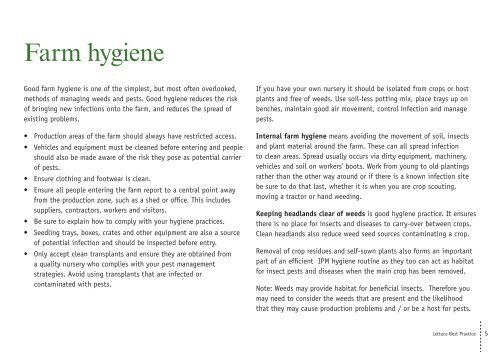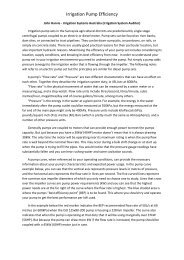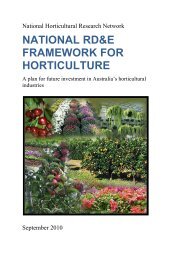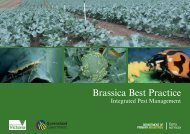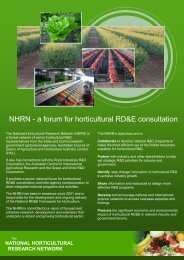Lettuce Best Practice - Department of Primary Industries
Lettuce Best Practice - Department of Primary Industries
Lettuce Best Practice - Department of Primary Industries
- No tags were found...
Create successful ePaper yourself
Turn your PDF publications into a flip-book with our unique Google optimized e-Paper software.
Farm hygieneGood farm hygiene is one <strong>of</strong> the simplest, but most <strong>of</strong>ten overlooked,methods <strong>of</strong> managing weeds and pests. Good hygiene reduces the risk<strong>of</strong> bringing new infections onto the farm, and reduces the spread <strong>of</strong>existing problems.• Production areas <strong>of</strong> the farm should always have restricted access.• Vehicles and equipment must be cleaned before entering and peopleshould also be made aware <strong>of</strong> the risk they pose as potential carrier<strong>of</strong> pests.• Ensure clothing and footwear is clean.• Ensure all people entering the farm report to a central point awayfrom the production zone, such as a shed or <strong>of</strong>fice. This includessuppliers, contractors, workers and visitors.• Be sure to explain how to comply with your hygiene practices.• Seedling trays, boxes, crates and other equipment are also a source<strong>of</strong> potential infection and should be inspected before entry.• Only accept clean transplants and ensure they are obtained froma quality nursery who complies with your pest managementstrategies. Avoid using transplants that are infected orcontaminated with pests.If you have your own nursery it should be isolated from crops or hostplants and free <strong>of</strong> weeds. Use soil-less potting mix, place trays up onbenches, maintain good air movement, control infection and managepests.Internal farm hygiene means avoiding the movement <strong>of</strong> soil, insectsand plant material around the farm. These can all spread infectionto clean areas. Spread usually occurs via dirty equipment, machinery,vehicles and soil on workers’ boots. Work from young to old plantingsrather than the other way around or if there is a known infection sitebe sure to do that last, whether it is when you are crop scouting,moving a tractor or hand weeding.Keeping headlands clear <strong>of</strong> weeds is good hygiene practice. It ensuresthere is no place for insects and diseases to carry-over between crops.Clean headlands also reduce weed seed sources contaminating a crop.Removal <strong>of</strong> crop residues and self-sown plants also forms an importantpart <strong>of</strong> an efficient IPM hygiene routine as they too can act as habitatfor insect pests and diseases when the main crop has been removed.Note: Weeds may provide habitat for beneficial insects. Therefore youmay need to consider the weeds that are present and the likelihoodthat they may cause production problems and / or be a host for pests.<strong>Lettuce</strong> <strong>Best</strong> <strong>Practice</strong> 5


